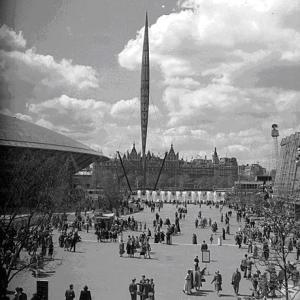Like ‘The King’s Speech’, ‘My Week with Marilyn’ presents an at least semi-historical account of the private life of a public figure; in this case: Marilyn Monroe. However, it also goes one step beyond, it opens up the ‘behind-the-scenes’ world of film-making in 1950sBritain.
Beginning with a look at the cinema experience, in the opening scene of the film, we are watching Marilyn (played by Michelle Williams) singing and doing some token ‘Marilyn-moves’. The shot then changes to one of the same view of her, but from the outside of the screen, as it is being watched in the cinema. As the audience in the cinema, we gain access to a view that would have been experienced by a cinema audience in the 1950s, and we become conscious of her own act of viewing from the cinema seat. Then, the camera turns on the audience, to the protagonist sitting transfixed by the images on screen: Colin Clark (played by Eddie Redmayne).
The film is based on Clark’s memoirs and we are shown that through a couple of well-mannered pesterings from him in early scenes, he manages to become Third Assistant director to Laurence Olivier, for the filming of ‘The Prince and the Showgirl’ at Pinewood Studios in 1957. ‘My Week with Marilyn’ then offers access to not only the characters of Monroe and Olivier (Kenneth Branagh), and their tense relationship, but also to the set design (seen behind Olivier in his office in one scene), the filming process and even the wardrobe department (allowing a slightly superfluous role for Emma Watson).
Watching the film, we are given a privileged look at how films were constructed, and the problems along the way. Marilyn’s character is shown to a troubled one: she is trapped within a constructed image herself: she asks Colin at one point: ‘Shall I be her? Marilyn?’ And indeed, she confronts this constructed world in a scene in which they visitWindsorCastletogether. As she peers into the Queen’s dolls house, we see her from within its interior. This is very much like our looks at the set design and wardrobe department of ‘The Prince and the Showgirl’, as a constructed environment.
In ‘The King’s Speech’, George VI’s stark metallic microphone often occupies a key position in shot, in an ominous, central position which obscures some of the scene behind. The microphone is a device which separates us as the audience from the scenes behind, and set in context, it separates the King reading his public announcement from the families listening to the wireless in their homes. In ‘My Week with Marilyn’, film takes this role as mediator between public and private. In the final scenes, Clark watches the test footage of ‘The Prince and The Showgirl’ as the last privately filmed images, and those he relates to his own relationship with Marilyn, before the film’s intertitles inform us of what happened next in the public lives of these figures. By showing the ‘behind-the-scenes’ world of 1950s film-making, we not only see the private lives of the film stars but the process by which these private scenes became part of a public image on the cinema screen.





















